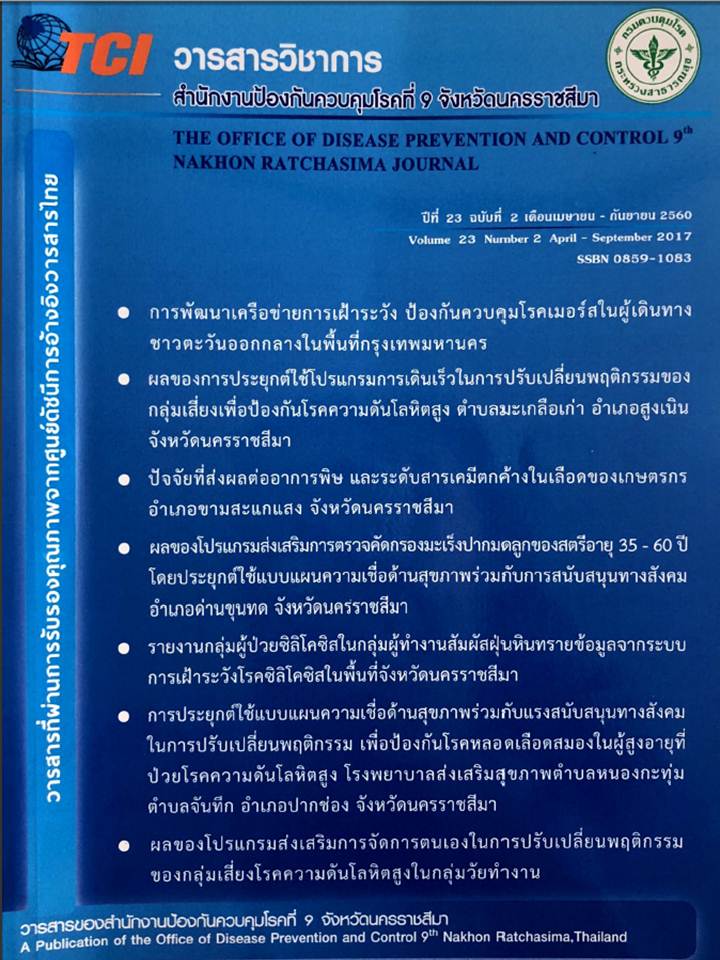Factors Affecting Poison and Blood Chemical Levels of Farmers in KhamSakaesaeng District, NakhonRatchasima.
Keywords:
farmers, chemical pesticide use, affecting factors, pesticide poisoning, blood chemical levelsAbstract
This study has objectives to evaluate the rate of system toxicity from the chemical residues
in the blood of farmers locating in Khamsaengsaeng District, NakhonRatchasima Province, and determine
the factors affecting the toxicity of the blood chemicals of farmers. A Questionnaire was used as an
instrument for collecting data from 400 farmers between October to December 2016 Statistics used
for data analyses were descriptive statistics presenting with frequency, percentage, mean, standard
deviation, and multivariable logistic regression. The results of chemical residues in farmer’s blood
found that most chemical substances caused the most toxic symptoms were the musculoskeletal
system 30.60%, followed by the nervous system 22.00% and the respiratory system 19.4%.
In the musculoskeletal system and tender, most symptom found was fatigue 30.9%. Nervous system
found was headache 45.9% and respiratory tract system was irritation and neck spasms 38.2%.
With the toxicity of chemicals in the farmer’s blood, the results from multivariable logistic regression
showed statistically signi cant at p-value <0.05 of spray duration (ORadj = 1.91, 95% CI = 1.15-2.41,
p-value <0.001), some weed species (ORadj = 4.15, 95% CI = 1.47-11.70, p-value = 0.006),
and chemical use behavior (ORadj = 0.45, 95% CI = 0.32-0.65, p-value <0.001). In conclusion,
toxicity in farmer’s blood chemicals still a major problem. All sectors must seriously collaborate
and work together to reduce chemical residues in both agricultural related work and in vegetables which
may alleviate public health in general population.
References
ส่งออก นำเข้า และดุลการค้า [อินเทอร์เน็ต]. สำนักงานเศรษฐกิจการเกษตร; 2559 [เข้าถึงเมื่อ
24 ต.ค. 2559]. เข้าถึงได้จาก: http://www.oae.go.th/download/download_journal/2559/yearbook58.
pdf.
2. ไทยพับลิก้า. กรมควบคุมโรคชี้ผลเลือดเกษตรกรมีสารเคมีตกค้างระดับไม่ปลอดภัยนับแสนราย-5 จังหวัด
อันตราย สุโขทัย อุดรธานี เลย อำนาจเจริญและเพชรบุรี[อินเทอร์เน็ต].กรุงเทพฯ:กรมควบคุมโรค
สำนักโรคจากการประกอบอาชีพ และสิ่งแวดล้อม;2558 [เข้าถึงเมื่อ 24 ต.ค. 2559]. เข้าถึงได้จาก:
http://thaipublica.org/2015/04/toxic-food-crisis-15/.
3. บริษัท เอ็นพีซี เซฟตี้แอนด์ เอ็นไวรอนเมนทอล เซอร์วิส จำกัด. พิษภัยของสารเคมีการเกษตร [อินเทอร์เน็ต].
ระยอง: บริษัท เอ็นพีซี เซฟตี้แอนด์ เอ็นไวรอนเมนทอล เซอร์วิส จำกัด; 2559 [เข้าถึงเมื่อ 24 ต.ค.
2559]. เข้าถึงได้จาก: Firefox : le:///F:/%E0%B8%AA%E0%B8%B2%E0%B8%A3%E0%B9%
80%E0%B8%84%E0%B8%A1%E0%B8%B5/NPC%20Safety%20and%20Environmental%20
Service%20Co.,Ltd..html.
4. สำนักงานเกษตรอำเภอขามสะแกแสง. ข้อมูลของเกษตรกรในแต่ละตำบลของ อำเภอขามสะแกแสง จังหวัด
นครราชสีมา. สำนักงานเกษตรอำเภอขามสะแกแสง(เอกสารอัดสำเนา), 2559.
5. สาธารณสุขอำเภอขามสะแกแสง.ข้อมูลผลการตรวจเลือดประเมินความเสี่ยงต่อสารเคมีที่สะสมในร่างกาย
ของเกษตรกร อำเภอขามสะแกแสง จังหวัดนครราชสีมา. สำนักงานสาธารณสุขอำเภอขามสะแกแสง
(เอกสารอัดสำเนา), 2559.
6. สนาน ผดุงศิลป์. ความรู้และพฤติกรรมการใช้สารเคมีกำจัดศัตรูพืชของเกษตรกร ตำบลวังสรรพรส อำเภอขลุง
จังหวัดจันทบุรี. วิทยานิพนธ์รัฐประศาสนศาสตรมหาบัณฑิต สาขาวิชาการจัดการภาครัฐ และภาคเอกชน
วิทยาลัยการบริหารรัฐกิจ มหาวิทยาลัยบูรพา, 2556.
7. วิทญา ตันอารีย์ และสามารถ ใจเตี้ย. การประเมินผลกระทบสุขภาพจากการใช้สารเคมีทางการเกษตร
ในการปลูกพืชไร่ เขตเทศบาลเมืองเมืองแกนพัฒนา อำเภอแม่แตง จังหวัดเชียงใหม่ [อินเทอร์เน็ต].
เชียงใหม่: คณะวิทยาศาสตร์และเทคโนโลยี มหาวิทยาลัยราชภัฏเชียงใหม่; 2554 [เข้าถึงเมื่อ
24 ต.ค. 2559].เข้าถึงได้จาก: http://thaigcd.ddc.moph.go.th/uploads/ le/KM/8%20Research%
20CMRU.ac.th-1-SCI-14-53.pdf.
8. ทศพล พรพรหม. สารกำจัดวัชพืช หลักการและกลไกการทำลาย [อินเทอร์เน็ต]. กรุงเทพฯ: มหาวิทยาลัย
เกษตรศาสตร์; 2545 [เข้าถึงเมื่อวันที่ 24 ตุลาคม 2559]. เข้าถึงได้จาก: http://lis.snru.ac.th/
BibDetail.aspx?bibno=66076.
9. จริยา ม่วงงาม. ปัจจัยที่มีผลต่อการตกค้างของสารเคมีป้องกันกำจัดศัตรูพืชในเลือดของเกษตรกร: กรณีศึกษา
จังหวัดสุโขทัย. วิทยานิพนธ์มหาบัณฑิต วิทยาศาสตร์ (เทคโนโลยีการวางแผนสิ่งแวดล้อมเพื่อการพัฒนา
ชนบท) บัณฑิตวิทยาลัย มหาวิทยาลัยมหิดล, 2544.
10. พิมาน ธีระรัตนสุนทร.ปัจจัยที่มีผลต่อระดับเอนไซม์โคลีนเอสเตอเรสในเลือดเกษตรกรที่ปลูกส้มโอ
ในตำบลคลองน้อย อำเภอปากพนัง จังหวัดนครศรีธรรมราช. ว. อนามัยสิ่งแวดล้อม [อินเทอร์เน็ต].
2559 [เข้าถึงเมื่อ 24 ต.ค. 2559];18: 3-17.เข้าถึงได้จาก: http://doc4.clib.psu.ac.th/public32/
article/south/410500.pdf.
11. Wayne W., D. Biostatistics : A Foundation of Analysis in the Health Sciences (6th ed.). John Wiley &
Sons, Inc., 1995;180.

Published
How to Cite
Issue
Section
License
บทความที่ลงพิมพ์ในวารสารวิชาการสำนักงานป้องกันควบคุมโรคที่ 9 จังหวัดนครราชสีมา ถือว่าเป็น
ลิขสิทธิ์ สำนักงานป้องกันควบคุมโรคที่ 9 จังหวัดนครราชสีมา



